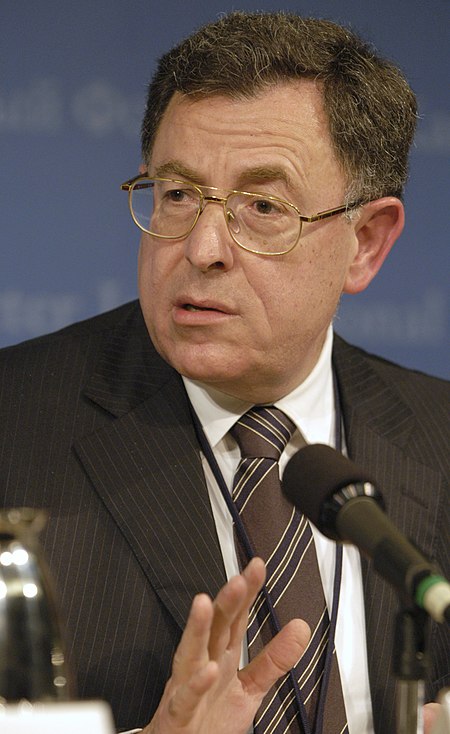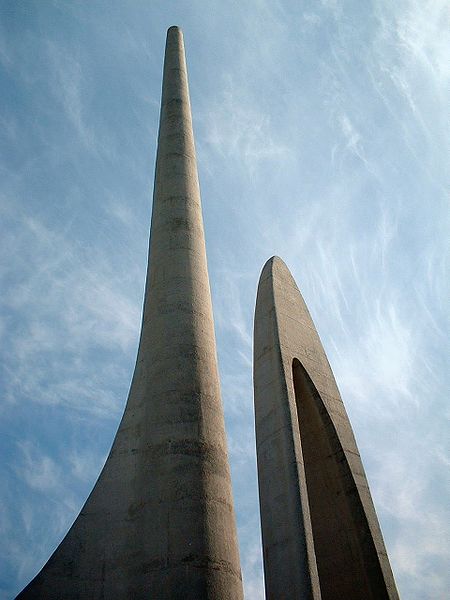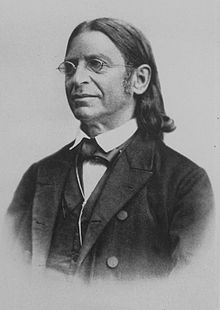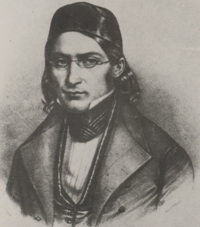Abraham Geiger
| |||||||||||||||||||||||||||||||||||
Read other articles:

Si ce bandeau n'est plus pertinent, retirez-le. Cliquez ici pour en savoir plus. Cet article ne cite pas suffisamment ses sources (juillet 2019). Si vous disposez d'ouvrages ou d'articles de référence ou si vous connaissez des sites web de qualité traitant du thème abordé ici, merci de compléter l'article en donnant les références utiles à sa vérifiabilité et en les liant à la section « Notes et références ». En pratique : Quelles sources sont attendues ? Comm…

American politician William Behan1893 portrait of Major William J. BehanMayor of New OrleansIn officeNovember 20, 1882 – April 28, 1884Preceded byJoseph A. ShakspeareSucceeded byJ. Valsin Guillotte Personal detailsBornSeptember 25, 1840New Orleans, LouisianaDiedMay 4, 1928 (aged 87)New Orleans, LouisianaPolitical partyDemocraticOther politicalaffiliationsRepublicanAlma materWestern Military InstituteMilitary serviceAllegiance Confederate StatesBranch/service Confederate States Ar…

Brazilian footballer This article has multiple issues. Please help improve it or discuss these issues on the talk page. (Learn how and when to remove these template messages) This biography of a living person needs additional citations for verification. Please help by adding reliable sources. Contentious material about living persons that is unsourced or poorly sourced must be removed immediately from the article and its talk page, especially if potentially libelous.Find sources: Alessandro…

60th season in franchise history 2019 Tennessee Titans seasonOwnerAmy Adams StrunkGeneral managerJon RobinsonHead coachMike VrabelHome fieldNissan StadiumResultsRecord9–7Division place2nd AFC SouthPlayoff finishWon Wild Card Playoffs(at Patriots) 20–13Won Divisional Playoffs(at Ravens) 28–12Lost AFC Championship(at Chiefs) 24–35Pro Bowlers 4 QB Ryan Tannehill (alternate)RB Derrick HenryDE Jurrell Casey (alternate)P Brett Kern AP All-Pros 3 RB Derrick Henry (2nd team)FLEX Derrick Hen…

The Leicestershire Yeomanry (Prince Albert's Own)Cap badge of The Leicestershire Yeomanry (P.A.O)Active1794–18021803–1957Country Kingdom of Great Britain (1795–1800) United Kingdom (1801–1957)Branch British ArmyTypeYeomanrySizeRegimentHQLeicesterNickname(s)Albert LadsPatronAlbert, Prince ConsortMotto(s)vultus en hostem face the enemyMarchRegimental March by Henry Nicholson jnr (1825-1907)Mascot(s)Veld Baboon, Adonse, from 1901 until his demise. Buried in Woodhouse Eves, Le…

Member of Legislative Assembly 2016 Tamil Nadu Legislative Assembly election ← 2011 16 May 2016 (2016-05-16) (232 Seats) 19 November 2016 (2 Seats) 2021 → All 234 elected seats in the Tamil Nadu Legislative Assembly118 seats needed for a majorityTurnout74.81% ( 3.48%) First party Second party Leader J. Jayalalithaa M. Karunanidhi Party AIADMK DMK Alliance Unallied UPA Leader since 1989 1969 Leader's seat Dr. Radhakrishnan Nagar Thiruva…

The flag of Lebanon. Prime Minister Fouad Siniora. Lebanon's position in the 2006 Israel–Lebanon conflict from the start was to disavow the Hezbollah shelling and raid on 12 July, while calling for an immediate ceasefire and the withdrawal of all Israeli forces from Lebanese territory. On 13 July, after an emergency meeting of the Lebanese government, Prime Minister Fouad Siniora stated that the government had not been aware of Hezbollah's raid before it happened and does not take responsibili…

Mario Suárez Informasi pribadiNama lengkap Mario Suárez MataTanggal lahir 24 Februari 1987 (umur 37)Tempat lahir Alcobendas, SpanyolTinggi 1,86 m (6 ft 1 in)Posisi bermain Gelandang bertahanInformasi klubKlub saat ini Atlético MadridNomor 4Karier junior1999–2004 Atlético MadridKarier senior*Tahun Tim Tampil (Gol)2004–2006 Atlético B 38 (4)2005–2008 Atlético Madrid 4 (0)2006–2007 → Valladolid (pinjaman) 23 (3)2007–2008 → Celta (pinjaman) 26 (2)2008–2010 M…

Transport company Not to be confused with Suez (company, 1997–2008) or Suez (company, 2015). Compagnie de SuezFormer head office of the Suez Company at 1 rue d'Astorg in ParisIndustryTransportation infrastructure, then investmentFounded1858FounderFerdinand de LessepsDefunct1997FateMerger to form Suez-Lyonnaise des eauxSuccessor Banque Indosuez Engie Suez HeadquartersParis The Suez Company or Suez Canal Company, full initial name Compagnie universelle du canal maritime de Suez (Universal Compan…

West Germanic language For peoples and persons from Africa, see Africans. For white Afrikaans speakers, see Afrikaners. AfrikaansPronunciation[afriˈkɑːns]Native to South Africa Namibia Botswana Zambia Zimbabwe Native speakers7.2 million (2016)10.3 million L2 speakers in South Africa (2011)[1]Language familyIndo-European GermanicWest GermanicWeser–Rhine GermanicLow FranconianDutchCentral DutchHollandicAfrikaansEarly formsFrankish Dutch Writing systemLatin script (Af…

Group of three islands off the west coast of Ireland Not to be confused with Isle of Arran or Arranmore. Aran IslandsNative name: Oileáin ÁrannLocation of Aran IslandsGeographyLocationGalway BayCoordinates53°05′50″N 9°37′57″W / 53.0971°N 9.6326°W / 53.0971; -9.6326Total islands3Major islandsInishmore (Árainn / Inis Mór)Inishmaan (Inis Meáin)Inisheer (Inis Oírr)Area46 km2 (18 sq mi)Highest elevation120 m (390 ft)Highest …

Kenneth J. Gray Kenneth James Gray (14 November 1924 – 12 Juli 2014) adalah seorang pengusaha dan politikus Amerika Serikat. Ia adalah veteran Perang Dunia II, dan mewakili Illinois dalam DPR dari 1955 sampai 1974, dan lagi dari 1985 sampai 1989. Pranala luar Kenneth J. Gray di Biographical Directory of the United States Congress Kenneth J. Gray 1924-2014 at YouTube.com, uploaded by Steve Grzanich, July 14, 2014 Family remembers the life of Congressman Ken Gray at YouTube.com, Gi…

Генерал-майор Країна УкраїнаВид збройних сил СВ ЗСУ та ДШВ ЗСУ Повітряні сили ЗСУСили спеціальних операцій ЗСУЗвання не-НАТО OF-7Категорія вищий офіцерський складСтворено 1991Вище звання Генерал-лейтенантНижче звання Бригадний генералРівноцінні звання ВМС: Контр-…

San Francesco de GeronimoUno dei ritratti più antichi del santo del 1771 conservato a Napoli, nella Quadreria dei Girolamini, e maschera in cera del santo realizzata il giorno della morte e conservata nel santuario di Grottaglie Religioso NascitaGrottaglie, 17 dicembre 1642 MorteNapoli, 11 maggio 1716 (73 anni) Venerato daChiesa cattolica Beatificazione1806 da papa Pio VII Canonizzazione1839 da papa Gregorio XVI Ricorrenza11 maggio Patrono diRegno delle Due Sicilie, Grottaglie e…

Artikel ini sebatang kara, artinya tidak ada artikel lain yang memiliki pranala balik ke halaman ini.Bantulah menambah pranala ke artikel ini dari artikel yang berhubungan atau coba peralatan pencari pranala.Tag ini diberikan pada Oktober 2022. CODE-V adalah sebuah grup vokal laki-laki Korea Selatan. Code V awalnya bernama BLESS. Grup vokal dari CODE M Agency ini lahir di tahun 2011 dan terdiri dari 4 anggota. Sebetulnya BLESS sudah diumumkan ke public pada tahun 2007 dan memiliki 5 anggota. Tah…

كولن باول (بالإنجليزية: Colin Powell) مناصب مستشار الأمن القومي الأمريكي في المنصب23 نوفمبر 1987 – 20 يناير 1989 فرانك كارلوتشي برنت سكوكروفت رئيس هيئة الأركان المشتركة الأمريكية في المنصب1 أكتوبر 1989 – 30 سبتمبر 1993 ويليام جاي كرو ديفيد إي. جيريمياه …

If you leave a new message on this page, I will reply on this page unless you ask me to reply elsewhere. Archives Archive 1Archive 2Archive 3Archive 4Archive 5DABs and Admin MessagesDYK NominationsGA NominationsHyborian War/TFA/FACPlay-by-mail misc PBM Organizing After reorganizing the list page earlier today, I decided to go through the whole play-by-mail games category (well, not the video games) and sort everything there into categories. I skipped everything that you started or already edited…

Disambiguazione – Se stai cercando altri significati, vedi Palazzo Acerbi (disambigua). Palazzo AcerbiLocalizzazioneStato Italia LocalitàMilano Indirizzocorso di Porta Romana, 3 Coordinate45°27′36.54″N 9°11′22.55″E45°27′36.54″N, 9°11′22.55″E Informazioni generaliCondizioniIn uso CostruzioneXVII secolo StileBarocco UsoUffici RealizzazioneArchitettoCostantino Costantini Proprietariofamiglia nobile, Wolfgang Reichmann e Ludovico Acerbi Modifica dati su Wikidata · M…

This is the talk page for discussing WikiProject Caribbean and anything related to its purposes and tasks. Put new text under old text. Click here to start a new topic. New to Wikipedia? Welcome! Learn to edit; get help. Assume good faith Be polite and avoid personal attacks Be welcoming to newcomers Seek dispute resolution if needed Archives: 1Auto-archiving period: 90 days This project page does not require a rating on Wikipedia's content assessment scale.It is of interest to the following …

Town in SlovakiaPodolínecTownA church in Podolínec Coat of armsPodolínecLocation of Podolínec in SlovakiaCoordinates: 49°15′26″N 20°31′51″E / 49.25722°N 20.53083°E / 49.25722; 20.53083CountrySlovakiaRegionPrešovDistrictStará ĽubovňaFirst mentioned1235Government • MayorMichal Marhefka[1]Area[2] • Total33.76 km2 (13.03 sq mi) (2022)Elevation565[3] m (1,854[3] ft)Populat…


